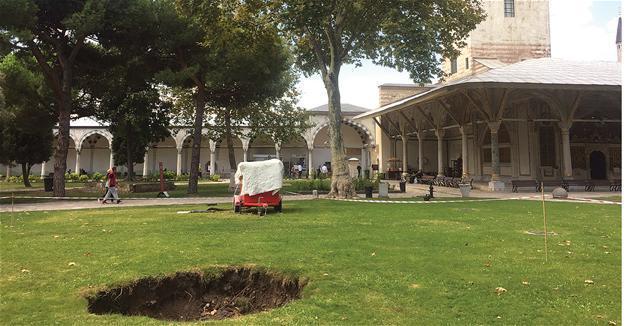Culture minister vows to address cracks and fragilities at Istanbul’s Topkapı Palace
ISTANBUL – Anadolu Agency

Turkish Culture Minister Nabi Avcı visited Istanbul’s historical Topkapı Palace on Oct. 3 after news reports that the popular Ottoman-era tourist site is riddled with dangerous cracks in its treasury room.
Avcı said the recent media coverage of the crevices in the basement floor of the palace’s treasury room, the Fatih Pavilion, which led to its artifacts being removed for security measures, wrongly reported these deep cracks as a new issue.
“These cracks are not a recently emerging issue. This is a situation that we as the ministry and the Topkapı [Palace] authority have been working on since Oct. 10, 2015,” said Avcı, adding that work was currently ongoing with Istanbul Technical University and Boğaziçi University.
The minister said 26 seismic wells will be dug to investigate the problem as part of the inspection work over the course of one month, revealing the frequencies, durations and power of the seismic threats. Fortification work would be carried out in line with this, he added.
Avcı pointed to a concrete dome built in the 1940s as the source of today’s cracks, as it had led to unsustainable and damaging pressure on the walls. The concrete dome will be removed and replaced with a wooden dome, he said.
“This way the walls will be cleared off pressure ... Recording the seismic data will take three to four months. Our forecast is that by early March this will be completed,” said Avcı.
He also touched upon the widely reported issue of large holes that have opened up in the garden of the Topkapı Palace.
Speaking anonymously to daily Hürriyet after its story on cracks in the Fatih Pavillion, a palace employee said a hole had emerged in the grass in the second yard of the palace.
A few years ago, the palace’s security chief fell into another hole that had appeared in the ground while walking around the site, the official said, adding that this specific hole stemmed from an Ottoman-era water pit located under the ground.
“Some media outlets have reported on the hole as if it is three-meters deep. Its diameter may be three meters but its depth only is around a meter. There is no situation that would pose a threat to our visitors. [Experts] think it was caused by the decaying of pipes tied to a cistern nearby and water filling up in the emerging spots. Ground work both in the visited areas and areas where the buildings are situated is carried out all the time,” Avcı also said.
 Turkish Culture Minister Nabi Avcı visited Istanbul’s historical Topkapı Palace on Oct. 3 after news reports that the popular Ottoman-era tourist site is riddled with dangerous cracks in its treasury room.
Turkish Culture Minister Nabi Avcı visited Istanbul’s historical Topkapı Palace on Oct. 3 after news reports that the popular Ottoman-era tourist site is riddled with dangerous cracks in its treasury room.